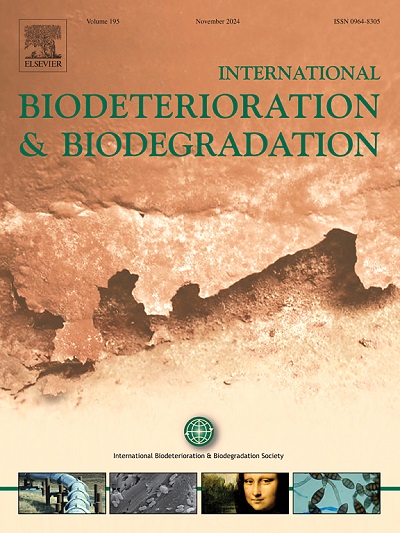表面活性剂清洁-生物强化协同修复重度石油污染土壤:现场验证与微生物机制
IF 4.1
2区 环境科学与生态学
Q2 BIOTECHNOLOGY & APPLIED MICROBIOLOGY
International Biodeterioration & Biodegradation
Pub Date : 2025-03-30
DOI:10.1016/j.ibiod.2025.106079
引用次数: 0
摘要
石油污染物构成重大的环境和人类健康风险,突出表明迫切需要开发有效的方法来修复严重石油污染的土壤。目前的表面活性剂清洁-生物增强耦合技术面临着修复效果不够深刻的挑战。本研究在某油田进行了复合表面活性剂加生物强化清洗方法的现场研究。最初,用复合表面活性剂sds - tx100洗涤含有153200±1700 mg/kg总石油烃(TPH)的土壤,TPH降至36800±1800 mg/kg。随后,使用一种新型菌群进行生物强化修复92天,将TPH降至7600±400 mg/kg,降解率为79.35%。原油4种组分中饱和烃、芳烃、树脂和沥青质的降解率分别为73.08%、73.24%、74.19%和77.78%。土壤中C10-C40由4080 mg/kg降至330 mg/kg,符合《中国土壤环境质量-建设用地土壤污染风险控制标准(试制)》(GB 36600-2018)的一级土地利用筛选值(826 mg/kg)。这主要是由于土壤脱氢酶活性的增加和烷烃降解菌和芳香降解菌的富集。细菌联合体的引入有效调节了土壤微生物群落,使能够降解石油的功能细菌富集,从而加快了降解过程。本研究为表面活性剂复合清洁与生物修复协同修复重度石油污染土壤提供了新策略。本文章由计算机程序翻译,如有差异,请以英文原文为准。

Synergistic surfactant cleaning-bioaugmentation strategy enables deep remediation of heavily petroleum-contaminated soils: Field validation and microbial mechanism
Petroleum pollutants pose significant environmental and human health risks, highlighting the urgent need to develop effective methods for remediation of heavily petroleum-contaminated soil. Current surfactant cleaning-bioaugmentation coupled technologies encounter challenges of inadequate profound remediation efficacy. This study conducted a field study of a composite surfactant cleaning method coupled with bioaugmentation in an oilfield. Initially, soil containing 153200 ± 1700 mg/kg total petroleum hydrocarbons (TPH) was washed with the composite surfactant SDBS-TX100, and the TPH was reduced to 36800 ± 1800 mg/kg. Subsequently, 92 days of bioremediation by bioaugmentation using a novel bacterial consortium decreased the TPH to 7600 ± 400 mg/kg, with a degradation rate of 79.35 %. The degradation rates of saturated hydrocarbons, aromatic hydrocarbons, resins, and asphaltenes in the four components of crude oil in the soil were 73.08 %, 73.24 %, 74.19 %, and 77.78 %, respectively. The C10-C40 in soil decreased from 4080 mg/kg to 330 mg/kg, which met the screening value (826 mg/kg) for Class I land use according to the Chinese Soil Environmental Quality-Construction Land Soil Pollution Risk Control Standards (Trial) (GB 36600-2018). This significant reduction is primarily attributed to the increase of soil dehydrogenase activity and the enrichment of alkane-degrading and aromatic-degrading bacteria. The introduction of bacterial consortium effectively regulated the soil microbial community, resulting in the enrichment of functional bacteria capable of degrading petroleum, thus enhancing the degradation process. This study provides a new strategy for the synergistic remediation of heavily petroleum-contaminated soil through composite surfactant cleaning and bioremediation.
求助全文
通过发布文献求助,成功后即可免费获取论文全文。
去求助
来源期刊
CiteScore
9.60
自引率
10.40%
发文量
107
审稿时长
21 days
期刊介绍:
International Biodeterioration and Biodegradation publishes original research papers and reviews on the biological causes of deterioration or degradation.

 求助内容:
求助内容: 应助结果提醒方式:
应助结果提醒方式:


